It is with great enthusiasm and immense pride that we present the exceptional and challenging achievement of our club president, Capt. Dimitris Matthaiou, as recounted in a unique and personal journey. This remarkable accomplishment highlights the resilience required both at sea and in the untamed heights of Africa. Capt. Dimitris Matthaiou, CEO of Arcadia Shipmanagement and Chairman of the Green Award Foundation, has achieved a feat accomplished by few—the successful ascent to the summit of Mount Kilimanjaro. As a pioneering figure in Greece’s shipping industry, this accomplishment not only highlights a personal milestone but also serves as a testament to the relentless determination that defines leadership in challenging environments.
Mount Kilimanjaro, standing at 5,895 meters, is one of the Seven Summits, the highest peaks on each of the seven continents. The journey to its summit is a rigorous test of endurance, willpower, and mental fortitude—qualities that Capt Mattheou Dimitrios has consistently demonstrated throughout a distinguished career in the shipping industry.
This ascent is more than just a physical achievement; it symbolizes the broader challenges faced by leaders who navigate complex and often treacherous waters, whether they be in the boardroom or on the world’s tallest free-standing mountain. The parallels between leading a global maritime company and conquering one of the planet’s most formidable peaks are striking, reflecting a mindset that is undeterred by obstacles and driven by an unwavering commitment to success.
This remarkable journey stands as an inspiration, not only to those in the maritime community but to all who strive to push beyond their limits, defying the odds and achieving greatness. Capt Mattheou Dimitrios’ ascent of Kilimanjaro is a powerful reminder that with dedication, preparation, and the right mindset, even the highest mountains can be conquered.
See below for the detailed account of this incredible & extraordinary journey—an adventure that tested the limits of endurance and resilience, where every step taken towards the summit reflects the perseverance and strength that defines true leadership and ultimately led to the successful summit of Kilimanjaro.
Reaching the Summit of Kilimanjaro: A Journey of Endurance, Transformation, and Gratitude
After my highly successful ascents of the Mountain of the Gods, specifically to the two highest peaks of Mount Olympus (Mytikas at 2,918 meters and Skolio at 2,905 meters), as well as the second-highest mountain in Greece, Smolikas at 2,637 meters, I embarked on yet another remarkable journey. This time, I conquered the highest mountain in Africa, Mount Kilimanjaro in Tanzania, which is part of the Seven Summits—the highest mountains on each of the seven continents of the Earth.
Tanzania is a country in East Africa with an area of 945,087 square kilometers, including the islands of Mafia, Pemba, and Zanzibar. Tanzania shares two of Africa’s largest lakes with its neighboring countries: Lake Victoria in the north and Lake Tanganyika in the west.
One-third of the country is comprised of national parks and game reserves. Within its borders stands the highest mountain in Africa, Kilimanjaro. Kilimanjaro is located in northwestern Tanzania, near the equator. It is an isolated volcanic mountain massif with two peaks, the higher of which, Kibo (5,895 meters), is the highest point in Africa, connected by a saddle to the second peak, Mawenzi (5,149 meters). Kibo is the crater of a volcano that is gradually becoming extinct, while Mawenzi is also a crater of an extinct volcano, once taller but now eroded. Both peaks are covered with glaciers, which are the only ones near the equator. Kibo’s glacier descends to 4,900 meters.
The lower zones of the mountain, from 3,000 to 2,000 meters in altitude, are covered with pristine forests, while the lower regions form exceptional cultivation areas.
Conquering the Summit: A Journey Beyond Limits
More than 20 days have passed since the morning of August 2, 2024, when, along with fellow climber Yiannis Rigos, our Greek guide Georgios Raios, and our Tanzanian expedition leader Seleman, we reached the summit of Gilman’s Point at 5,685 meters on the Kibo crater of Mount Kilimanjaro in Tanzania. As with most journeys that leave deep impressions through their experiences, images, and lessons, what we lived continues to replay in our minds persistently, as if it happened yesterday.
Mount Kilimanjaro is the largest “free-standing mountain” in the world, meaning it is the tallest mountain that stands alone, without being part of a mountain range. Located in northeastern Tanzania, right next to the country’s border with Kenya, thousands of hikers and climbers attempt to conquer it each year, simultaneously experiencing the unique journey of crossing all five vegetation zones of the planet within a few days—from tropical rainforests to the lunar-alpine landscapes of the summit. However, less than half of these adventurers succeed (approximately 40-45%).
There are seven routes to ascend Kilimanjaro. Our team chose to follow the Marangu route (Coca-Cola Route), a 73-kilometer trail considered the most challenging yet shortest for acclimatization—the process your body needs to adapt to the increasingly high altitude, without succumbing to “high-altitude sickness,” the greatest enemy of climbers on high mountains due to the gradual lack of oxygen. This route is not only the toughest but also the most beautiful, circling the southwestern side of the mountain and offering the opportunity to witness the full extent of its natural splendor. Each day, it felt like walking on another planet, with dramatically different landscapes unfolding before us as we moved from camp to camp.
Forged by Determination: The Six-Month Journey to Summit Success
The successful summit of Kilimanjaro was the culmination of six months of intense preparation, marked by rigorous daily training and relentless determination. Each day, we pushed our bodies to the limit, engaging in demanding workouts that tested our endurance, strength, and resilience. We climbed mountain peaks, often in challenging conditions, to simulate the physical and mental demands we would face on Kilimanjaro. This preparation wasn’t just about building physical strength; it was about cultivating the mental fortitude needed to overcome the challenges of high altitude and extreme fatigue. The journey to the summit truly began long before we set foot on the mountain, with every training session, every ascent, and every moment of self-discipline contributing to our success.
THE JOURNEY – DAY 1
We began our journey on the afternoon of July 29, immediately after arriving at Kilimanjaro Airport. We met our guide, an exceptional and dedicated professional, Seleman. At the Marangu Gate entrance of Kilimanjaro National Park, at an altitude of 1,780 meters, while handling the administrative tasks, we also met the porters and the cook, who were recruited by the trekking companies to literally carry on their heads and backs the luggage of the clients and all the camping and climbing equipment. This allows participants to focus solely on their climb and acclimatization. Dressed in clothes usually donated by clients and visibly old and ill-fitting (mostly too large, as they are all extremely lean), wearing shoes we would consider barely suitable for disposal, these remarkable individuals carry everything—from gas canisters for cooking to fruits, vegetables, cooking utensils, and various supplies—racing ahead to the next camp not to rest but to fetch water, boil it, filter it, and prepare everything so that when we arrived, tired and worn out, we would find everything ready, including hot water to wash our hands.
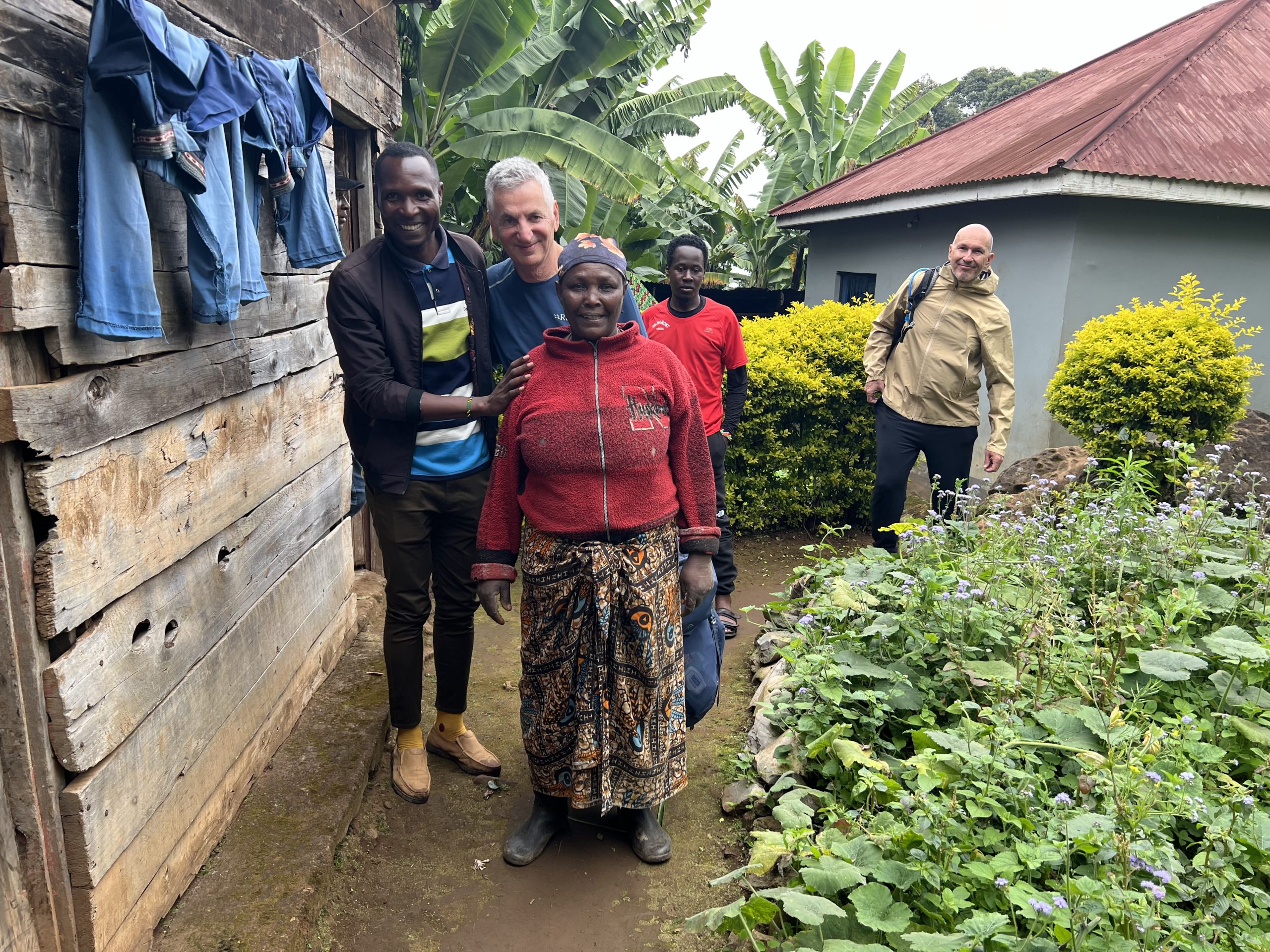
These admirable people, who form the backbone of Kilimanjaro’s trekking industry (without them, the mountain would not be as accessible), each carry 20 kilos on their heads and backs and earn the “colossal” sum of 15-20 dollars per day. Just a few years ago, they did all this without being provided with the necessary gear (backpacks, sleeping bags, tents, etc.) for dignified work and living conditions.
Despite these hardships, they continue to carry out their work with a quiet dignity, their strength and endurance unmatched, ensuring that others can experience the beauty and challenge of Kilimanjaro. It is a stark reminder of the inequities in our world, where those who toil the hardest often receive the least. This reality left us with a deep sense of responsibility to acknowledge and appreciate their efforts, and to advocate for better conditions and fairer compensation for these unsung heroes of the mountain.
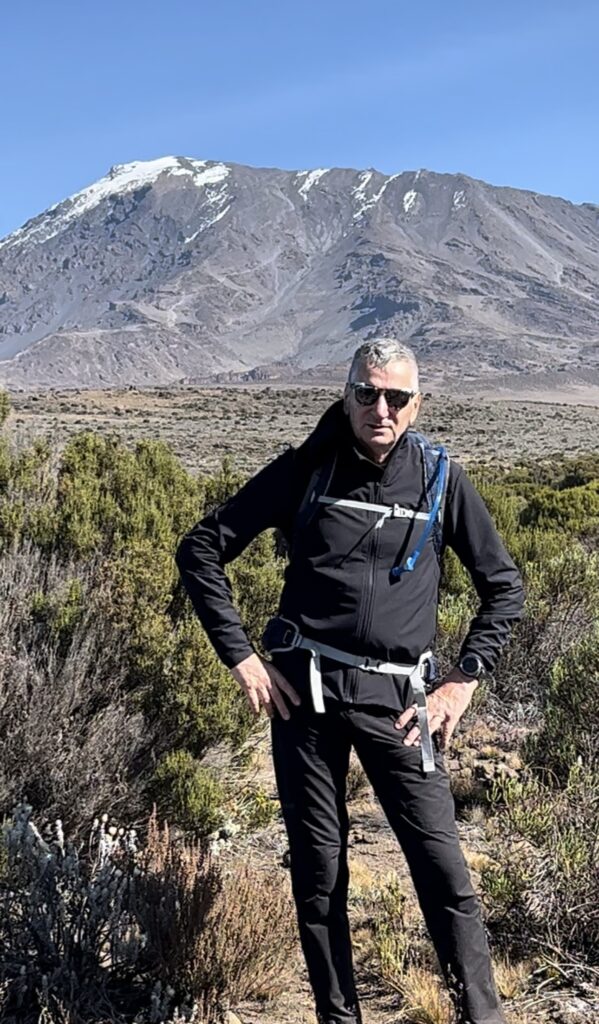
After this introduction to the porters, the “army” of Kilimanjaro, we started our trek. “Pole pole” in Swahili means “slowly, slowly.” This is the mountain’s motto. Slow, steady steps to avoid exhausting your body and to acclimatize better to the altitude. This was our routine every day, from camp to camp, hiking 6-10 hours daily, and as we gained altitude and our breath became shorter, as the incline grew steeper, we moved even more slowly. The space here is too limited to go into detail and describe each day. There are so many things one could write about our daily experiences, the constant displays of natural and otherworldly beauty this giant of Africa offered us. We started ascending, passing the first part of the mountain through a jungle, with monkeys dancing above our heads, until we reached Mandara Hut at 2,700 meters altitude, where we would spend the night. We also saw the unique “Giant Senecio Kilimanjari,” a rare, endemic tree, and the natural sculptures of solidified lava around us, and we thought, “This must have been planted here by another god.”
Our experience within the dense jungle was nothing short of magical and utterly immersive. From the moment we entered the forest, we were enveloped by the intense humidity, and the sounds of animals and birds filled the air, creating a symphony of perfect harmony with nature. The towering trees rose imposingly above our heads, their thick canopies forming a natural dome that blocked the sunlight from reaching the ground.
The jungle had a rich fragrance that combined the smell of damp earth with the sweet, earthy notes of flowers and plants. Every step was accompanied by the sound of dried leaves crunching underfoot, while the distant calls of animals constantly reminded us that we were guests in this ancient world.
Our encounter with the jungle was not just a hike; it was a profound experience of connection with nature, a reminder of the incredible diversity and beauty that exists in our world, and it made us feel grateful for every moment we spent there.
DAY 2:
Early in the morning, at Mandara Hut, while it seemed everyone was still sleeping, some were already ready to start their second day in such a pristine place to reach the Horombo Hut camp at 3,700 meters. After about two hours of a tough uphill hike, we caught sight of the imposing Mawenzi, standing alone among the low vegetation at 5,149 meters altitude. In the afternoon, we ascended to Horombo Hut at 3,700 meters altitude, where we would rest for the night.
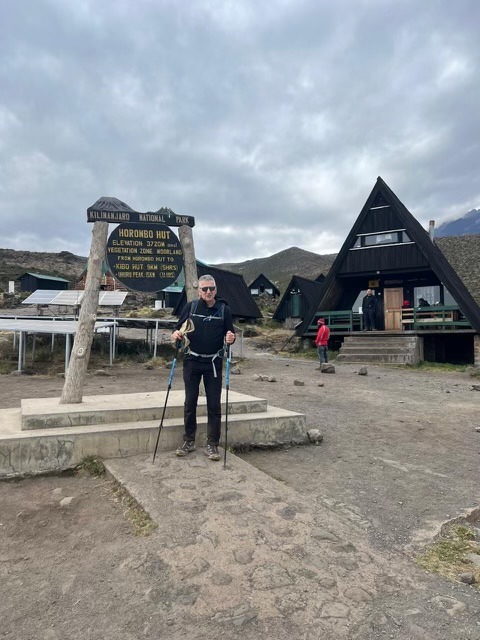

The third camp, Horombo at 3,700 meters, was the most beautiful. Nestled among countless Giant Senecio, with an incredible view over Moshi (the launch city at the foot of the mountain) on one side and the Kibo glaciers on the other, it felt like a small, well-deserved prize for our efforts up to that point, but it also marked a turning point: the easy part was over.
DAY 3 – ACCLIMATIZATION DAY
10:00: After a peaceful sleep at Horombo Hut located at 3,700 meters altitude, a relaxing yet important day of acclimatization arrived. We had a light breakfast and started our day full of energy and good spirits. We began ascending, and after 2 hours, we reached a very beautiful and unique place, where the rocks seem to have envied the stripes of a zebra—Zebra Rocks, located at 4,200 meters altitude.
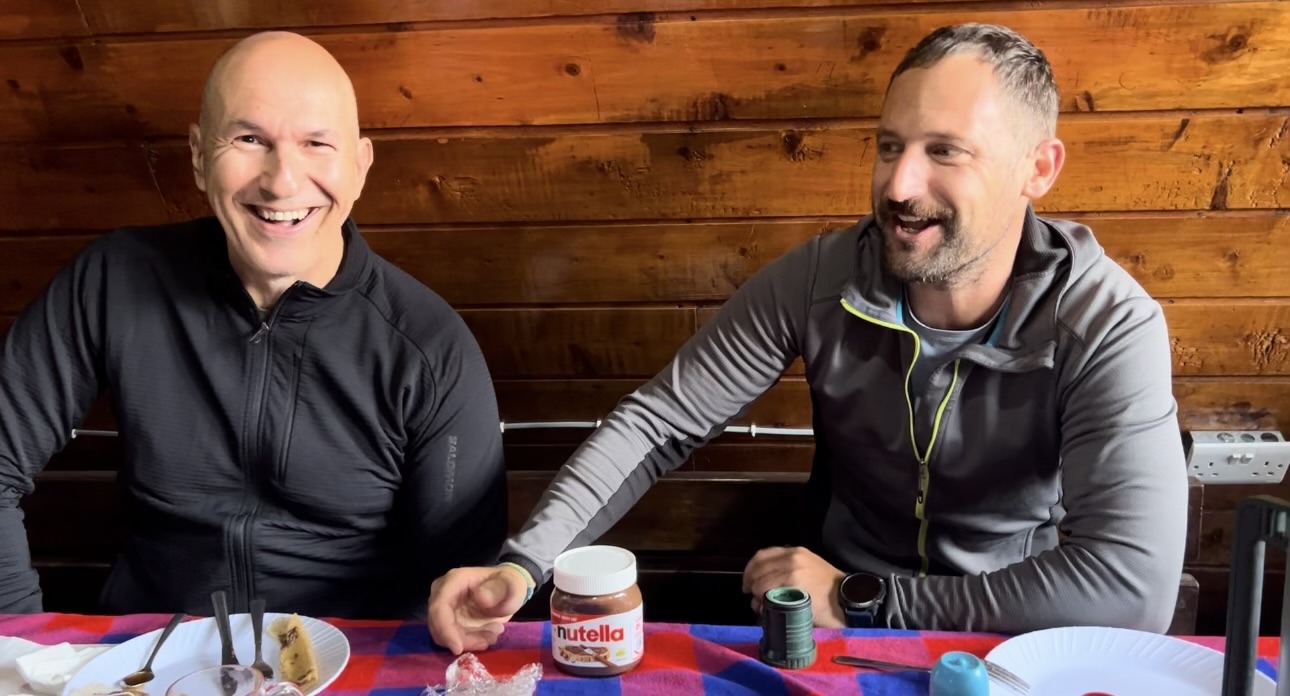
The Zebra Rocks location is magical, situated in volcanic terrain with low vegetation, where we saw marmots running around. For your information, Zebra Rocks is a very popular spot for climbers on the Marangu Route, as it is a key part of the journey to acclimatize to the altitude before reaching the coveted summit of Kilimanjaro, which stands at 5,895 meters. After admiring the breathtaking landscape, we started our way back to Horombo Hut. There, we enjoyed a hearty lunch, relaxed, and went to bed early.
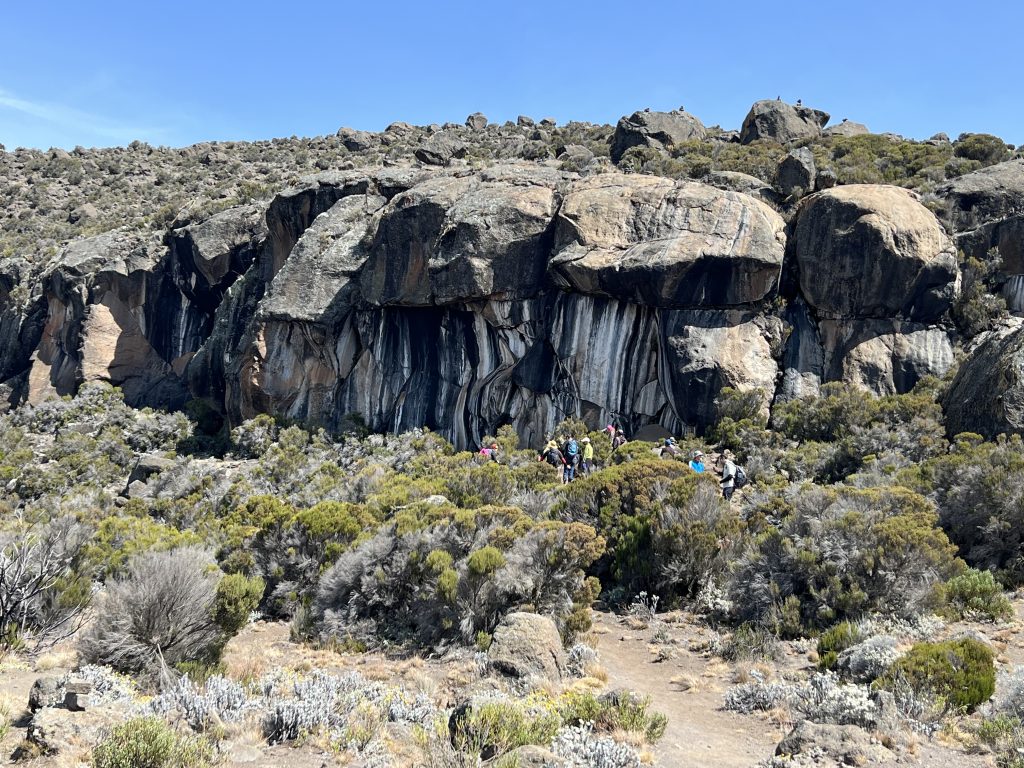
DAY 4:
The fourth day is a transition from low vegetation to vast, windswept landscapes. As you get closer to your destination at the Kibo Hut camp, at 4,700 meters altitude, you begin to crave touching the summit of Kilimanjaro.
At this final stretch before the summit, at 4,700 meters altitude, we felt like the oxygen supply had been completely cut off. Any faster, and you’d be close to collapse. The incline was insane, and the oxygen was practically non-existent. No matter how wide you opened your mouth—like a crocodile’s jaw unhinged (since the oxygen felt insufficient from the nose)—you couldn’t get a decent breath. The landscape around us, scorched by the lava of history, was dead, lunar, ready to welcome our bones. Anyone who saw us in those last meters of the trail would think we had no life left. Yet, slowly but surely, we reached the camp, a pile of rocks and stones “decorated” with some tents. After a brief clearing in the weather that gifted us a beautiful sunset scene above the orange clouds, just before darkness fell, the mountain stood before us as imposing as we had ever seen it: A massive lava wall, over 1,300 meters tall, with the Kibo crater glaciers gleaming like razors at the top.
It was clear that Kilimanjaro had decided to test our resolve.
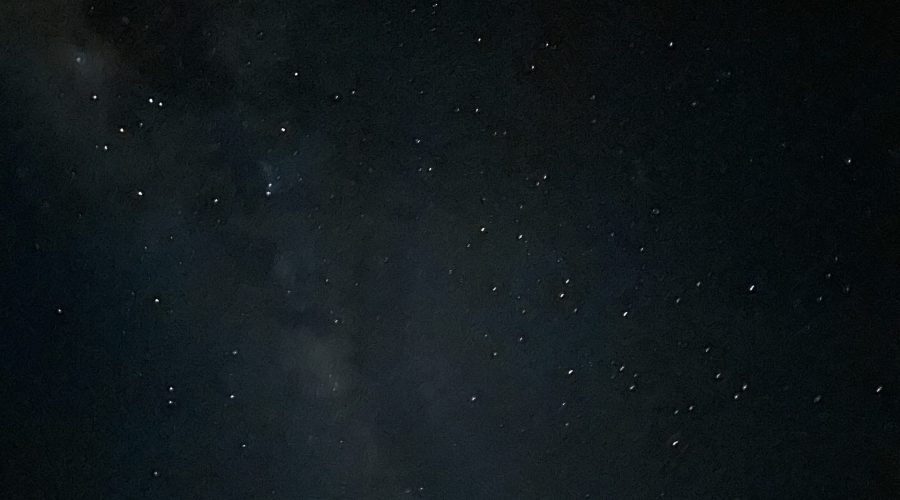
The Kibo Hut, perched at 4,700 meters, is a stark and awe-inspiring place, surrounded by an otherworldly landscape. The barren, rocky terrain stretches out in every direction, with the imposing Kibo peak looming above, its glaciers glistening in the cold, thin air. The air here is crisp and biting, and the wind often howls through the camp, adding to the sense of isolation and grandeur. The hut itself, though basic, offers a brief respite from the harsh elements outside. As night falls, the sky transforms into a dazzling display of stars, a reminder of the vastness of the universe and the smallness of our presence on this majestic mountain.
A little later, at dinner, we asked ourselves how we felt, knowing that our immediate future hinged on our answers. And there, in the frozen hut, amidst the chaos of our conversation, our guide burst in. He looked us both in the eyes and asked, “How do you feel?” After hearing our answers, he declared, “It is decided. We will summit tonight.” I don’t recall any serious objections, but I vividly remember what he emphasized: “You are tired, and I know it. But up there, it won’t be your body that gets you to the top. It will be your willpower. That is all that separates you from the summit.” The meeting was set for 22:00 in the hut for tea. We would depart immediately.
DAY 5 – TRIUMPH AT THE SUMMIT
We arrived at Kibo Hut at 16:00, where we tried to get some rest while listening to the wind relentlessly battering anyone brave enough to venture outside the refuge huts. Surely, at some point, we thought something very cliché in such circumstances: “What the hell am I doing here?” We woke up at 22:00, got out of our warm sleeping bags for tea, and confirmed with our guide that we were ready to set off for the summit and had everything we needed.
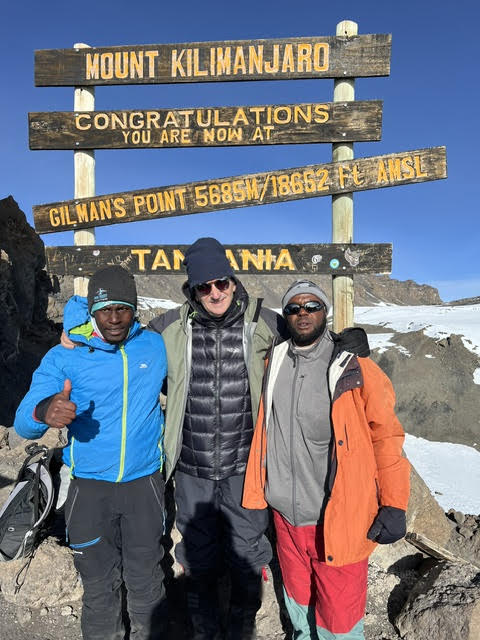
Then, we set off. We measured our oxygen levels, which had already dropped to a concerning 78-82%. We were fully aware that as we ascended further, our oxygen levels would likely plummet to dangerous lows, possibly reaching 70-75% when at the summit, putting us at significant risk of severe altitude sickness. This condition, known as Acute Mountain Sickness (AMS), can lead to life-threatening complications such as pulmonary embolism or cerebral edema if not properly managed. The stakes were high, and the potential dangers were clear.
Despite the very real possibility of catastrophic health issues, including the threat of stroke or pulmonary failure, we made the courageous decision to push onward. We knew that each step toward the summit was a gamble with our bodies’ limits, especially since we had chosen to continue without taking the medication commonly used to prevent altitude sickness. This decision was not made lightly; it was driven by our unwavering determination to reach the summit and our trust in the strength of our preparation and resolve. In the face of such daunting risks, we embraced the challenge, knowing that this was the ultimate test of our endurance, willpower, and sheer courage.
Of course, as is customary at such moments, I, as the team leader, felt inspired to deliver the traditional motivational speech before departure. I doubt my fellow climber Yiannis heard or cared much, as our thoughts were now solely on survival. So, we began…
We departed at 23:00 for Gilman’s Point, 5,640 meters high, where we climbed the steep rocky slope using our hands and feet. The first few hours were spent in absolute darkness, as the dense cloud cover blocked what little moonlight there was. The temperature worsened the situation, dropping to about fourteen degrees below zero. The oxygen remained scarce, and the overall conditions were challenging. The only view was the boots of the person in front, and our only concern was maintaining a steady pace—step by step, breath by breath—trying not to lose any precious oxygen, navigating through the vast darkness with only our headlamps to guide us and help us avoid the cliffs.
Shortly after we began, five more teams of 3-7 people each started their ascent. Looking back, we saw their headlamps blinking as they climbed. Half of them, at some point, decided they didn’t have the strength to continue and turned back, which wasn’t encouraging for us.
When the sun finally rose, it rewarded us with a stunning sight. Mawenzi, the lower peak, and the Marangu Valley below were bathed in a red glow from the fresh morning light. It was worth stopping to admire, even if it meant freezing. What a place, my God… But as soon as you finished marveling at Mawenzi and its view and turned your head further north, a wave of melancholic disappointment hit you: The Kibo crater ridge (our first target) still seemed impossibly far away, towering vertically above our heads like a giant, upright cucumber. It was as if we hadn’t walked ten hours, not even a hundred meters… We continued, slowly and steadily, deep in thought. Mr. Seleman, our Tanzanian expedition leader, kept singing mountain songs loudly, clearly, and professionally to encourage us not to give up. The pace of each step had slowed to an agonizing crawl, requiring at least 10 seconds per step and a break every five meters to catch our breath, as the lack of oxygen made our chests feel like they were about to explode. By now, the symptoms of altitude sickness were very pronounced, with severe headaches, nausea, and a constant urge for diarrhea.
Time passed, and our breaths and steps became heavier. It was so easy to say, “To hell with it, that’s enough! I’m freezing, bored, exhausted.” To turn around and leave Kili behind, laughing sarcastically at you… “There goes another one.” And yet, even in that hardest part before the crater, where the slope felt like walking on a greased slide, I don’t believe any of us even considered it. No one wanted to miss the rendezvous.
Throughout this grueling journey, we were fortunate to have George Raios, our Greek guide, by our side. His unwavering support and encouragement were invaluable, especially during the most challenging moments. George was more than just a guide; he was a constant source of motivation, reminding us why we had embarked on this adventure and pushing us to keep going when our spirits faltered. His deep knowledge of the mountain and his ability to anticipate our needs made all the difference. With every step, George was there, offering advice, sharing in our struggles, and ensuring that we never lost sight of our goal. Without his guidance and his tireless belief in our ability to succeed, reaching the summit would have been a far more daunting task. We are deeply grateful for his dedication and the vital role he played in making this journey a success.
We arrived at Gilman’s Point on Kilimanjaro at 08:00, standing at 5,681 meters altitude, where few people have reached. When you get there, theoretically, you could start celebrating, but the utter exhaustion of your body doesn’t allow you to fully enjoy even this majestic moment.
At this point, we took a break to admire the incredible view, literally gasping for breath as we gazed at the vast Kibo crater, stretching out at our feet—a vast, flat, earthen expanse that once boiled with the fire of the earth. The sight was unique. The pristine spot at Gilman’s Point, and then, after catching our breath and gathering strength and courage, we prepared for the descent.
We touched the summit sign, took the necessary photos, watching the other teams make their way up, and somewhere there, time froze. In our minds, a crazy rewind occurred, bringing together so many images: from the climb up the couloir of Mytikas on Mount Olympus, to the rigorous preparation, a pile of papers and things for the trip, the noise and bustle of the preparations, our faces at the airport. A whirlwind of emotions came together in a split second and closed behind us like a door. Of course, we hugged, cried, and called our loved ones. But the most powerful moment was when each of us, alone, found those moments to sit on a rock at the summit, accompanied only by silence. Because in the mountains, as in life, you often need that silence. Just before you get up to leave, you hear that whisper one last time: “You did it, you rascal…” and you start the journey back down.
Reaching Gilman’s Point at 5,681 meters was like stepping into another world. The view was breathtaking—massive ice cliffs and snow-covered expanses stretched out across the Kibo crater, glistening under the early morning light. Below, a sea of clouds lay thick and low, making it feel as though we were standing on the roof of Africa, far above the world. The cold, crisp air, combined with the stunning, icy landscape, created a scene of serene yet awe-inspiring beauty, a moment that felt both humbling and exhilarating.
Touching this summit, we felt an incredible sense of accomplishment. Completing this immense challenge, we managed to overcome all the tremendous difficulties that such a formidable test can bring.
It was a constant battle with ourselves, with the challenges of altitude, fatigue, and exhaustion, but the feeling of conquering such an incredible goal rewarded us beyond measure.

Surely, somewhere in the world, there are places more or less beautiful than Kilimanjaro. Mountains that are easier or harder, lower or higher. People who resemble our Tanzanian friends or don’t resemble them at all. What is certain, for us who had the fortune to go there together as a group and experience what we did, is that no other journey will be like this one. Unique and unrepeatable. Some things, you see, you live and feel only once. And Kili is one of them. Its power, its energy, its soul becomes yours when you set foot on its soil. The giant mountain of Africa symbolizes freedom and hope for an entire people. When you go, don’t forget to do what the locals say: “Smile to the mountain, and the mountain will smile back at you!”
We returned to Kibo Hut at 4,700 meters at 16:00 the same day, but due to the lack of oxygen, we decided to change our plan. The overwhelming exhaustion and the risk of deep sleep at such a high altitude, coupled with inadequate acclimatization, raised serious concerns. We feared that in our deeply fatigued state, we might not wake up due to the dangerously low oxygen levels, potentially leading to pulmonary embolism or stroke. With this in mind, we made the prudent decision to descend to Horombo Hut at 3,700 meters, where we could spend the night more safely, arriving there at midnight on the same day.
DAY 6:
We descended to Mandara Hut at 2,700 meters altitude, where we took a quick rest, and then continued our descent to the park entrance at Marangu, at 1,780 meters altitude, arriving there at 16:00.
After a quick shower in the local hotel, we departed for the entrance of Marangu village, where, after a 5-kilometer drive on a dirt road, we arrived at the village’s elementary school, where we were welcomed by teachers and students, given a tour, and announced our donation for the construction of toilets for the students and the adoption of the school for the upgrade of its facilities.


As we arrived at the elementary school, the harsh reality of poverty-stricken, forgotten Africa became painfully evident. The facilities were in a dire state—classrooms without electricity or windows, toilets without water or power, and no playground to speak of. The schoolyard was muddy, littered with rocks, and far from the safe, clean spaces our children take for granted. Yet, despite these unimaginable conditions, the children greeted us with songs, their faces lit with genuine happiness and joy. It was heart-wrenching to witness their smiles, knowing they live in conditions a hundred years behind our Western world.
This visit filled me with deep melancholy and frustration. How can the wealthier nations of the world stand by while these children, and so many others across Africa, are left to endure such hardships? Their future is uncertain, marked by a lack of opportunities, jobs, and entrenched in poverty. Our donation, while a small step, is a commitment to improving the lives of these resilient children. We aim to give them a glimmer of hope, a spark of joy, and the possibility of a brighter future—one where they can thrive, not just survive. We must do more, collectively, to lift these children out of despair and into a world of possibility.
DAY 7 and 8:
We returned to the hotel, then proceeded to Kilimanjaro Airport in Arusha for our departure to Greece.
Echoes of Kilimanjaro: A Journey of Transformation and Endurance
As we boarded our flight home, a profound wave of emotions enveloped us—exhaustion from the grueling climb, but also a deep and overwhelming sense of accomplishment and gratitude. Africa had touched our souls in ways we never imagined, leaving an indelible mark that will forever be etched in our hearts. The memories of its breathtaking landscapes, the unyielding warmth of its people, and the profound connection we felt to this ancient land are now part of the very fabric of our being.

This adventure was far more than just a physical journey; it was a transformative odyssey that reshaped our understanding of resilience, both in nature and within ourselves. Kilimanjaro challenged us, broke us down, and then rebuilt us stronger, more determined, and more attuned to the silent strength that lies within. As we leave this sacred place, we do so not just as climbers who reached the summit, but as individuals who have been forever changed by the mountain’s spirit and the lessons it imparted. The echoes of Kilimanjaro’s challenges will continue to resonate within us, guiding us in every step of our lives, reminding us that we are capable of overcoming any obstacle, no matter how insurmountable it may seem.

As we reflect on this incredible journey, our deepest gratitude goes to Mr. Seleman, our Tanzanian expedition leader, whose unwavering guidance and infectious spirit kept us moving forward even in our darkest moments. His mountain songs and encouragement were a lifeline when we needed it most. We are also immensely thankful to the porters, whose smiles, patience, and friendly demeanor made this arduous journey not only possible but memorable. Their strength and dedication were the unsung heroes of our success, and we are forever indebted to them for helping us reach the summit.

